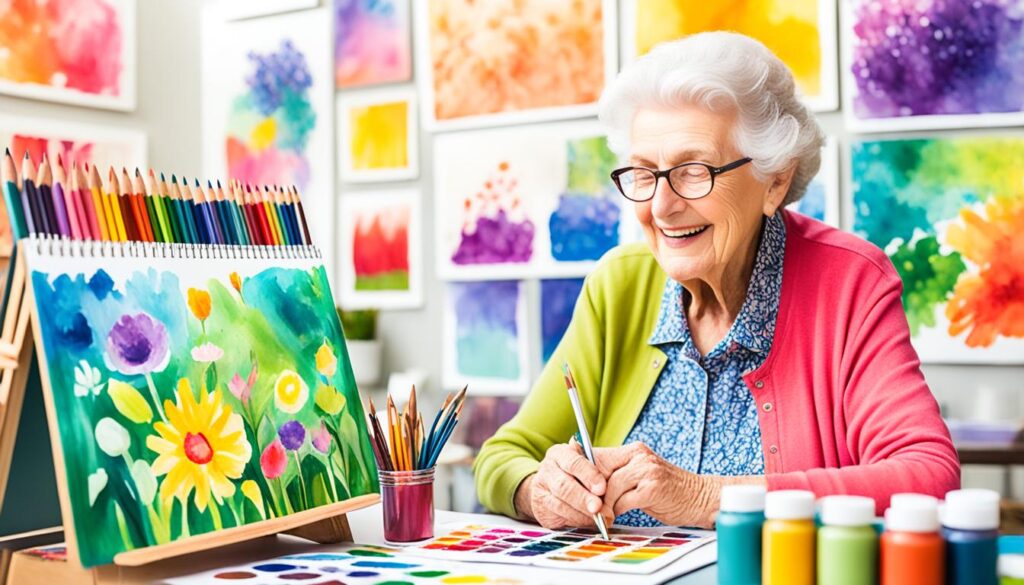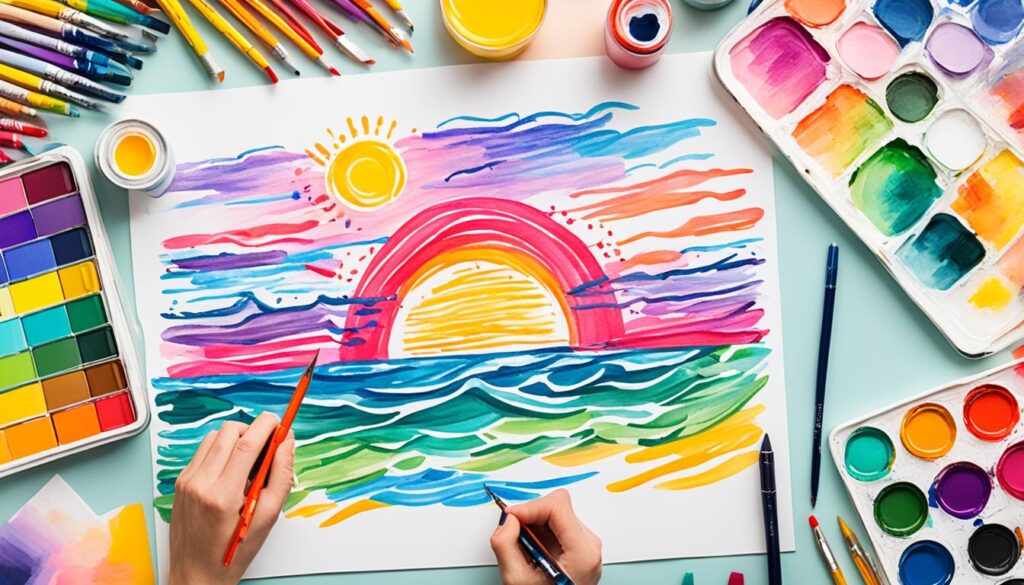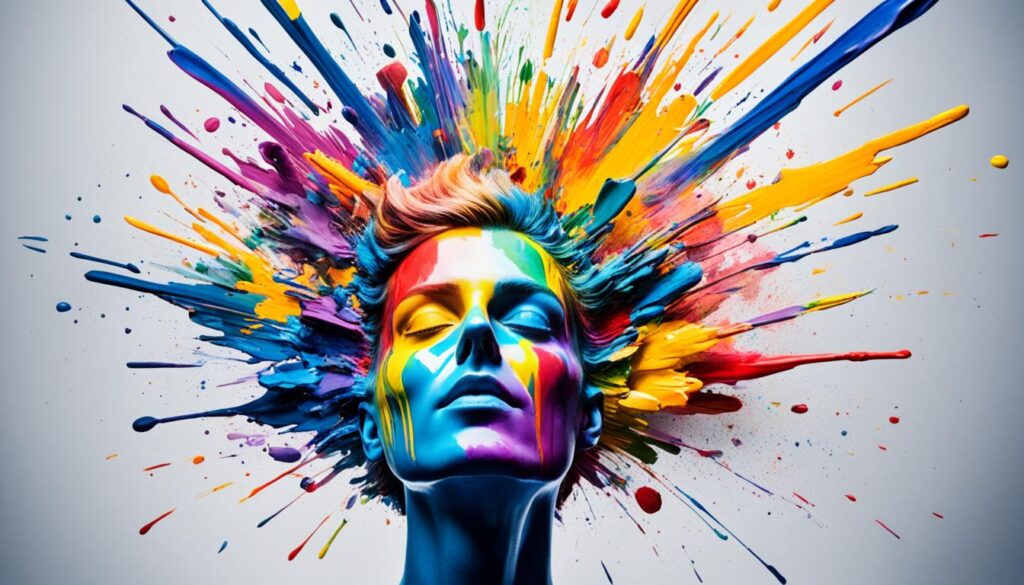When anxiety consumes you, it feels like a never-ending battle against your own mind. The racing thoughts, the pounding heart, the constant worry—it can be overwhelming, suffocating even. I know this struggle firsthand, as I've battled anxiety for as long as I can remember.
But amidst the chaos, I found solace and healing in an unexpected place: art therapy. Through the power of creativity and self-expression, art therapy has transformed my anxiety from a relentless foe into a friend I can embrace. And I'm not alone. Countless individuals have experienced the life-changing benefits of art therapy for their own anxiety.
Our Top Pick For Beating Panic Attacks

Stopping, and preventing, panic attacks is now even easier.
Today, I want to share with you three personal stories of individuals who have found hope and relief through art therapy. These testimonials serve as a testament to the transformative power of this therapeutic approach, demonstrating that art has the ability to heal our minds and soothe our souls.
Key Takeaways:
- Art therapy is a powerful tool for individuals struggling with anxiety.
- Personal stories highlight the transformative effects of art therapy on mental health and well-being.
- Art therapy offers a creative outlet for expression and allows for healing and growth.
- The therapeutic benefits of art-making extend beyond words, providing a unique form of communication and self-discovery.
- Art therapy is accessible and beneficial, regardless of artistic skill or background.
“Beth's Gift to Her Family”: Art Therapy for Late-Stage Dementia
Art therapy has the power to transcend language barriers, allowing individuals to express themselves in unique and meaningful ways. In the case of late-stage dementia patients, art therapy becomes a remarkable tool for communication and self-expression. One such story is that of Beth, a late-stage dementia patient who found solace and a new means of connecting with her family through art.
Laurie Dombroff, an experienced art therapist, was introduced to Beth during her time at a memory care facility. Despite Beth's cognitive decline and the challenges posed by late-stage dementia, Laurie recognized the potential for art therapy to provide a platform for Beth's inner voice to be heard.
Through the use of various art materials and techniques tailored to Beth's abilities and needs, Laurie guided Beth in the process of art-making. Beth's paintings and drawings became a window into her thoughts and emotions, allowing her to express herself in ways words could no longer convey.
“Art therapy allowed Beth to tap into her inner creativity and emotions, offering her a way to communicate that went beyond words,” Laurie reflects. “I witnessed her frustration melt away as she engaged with the art materials. It was as if the act of creating art unlocked a hidden part of her, bringing joy and connection back into her life.”
A particularly poignant moment came when Beth created a painting that touched the hearts of her family members. Unable to express her love and gratitude verbally, Beth used art to convey her emotions. The painting depicted a vibrant sunset, with colors blending together in a harmonious display. It became a symbol of Beth's love and a visual representation of her gift to her family.
The impact of Beth's artwork on her family was profound. They were able to understand and receive her message, feeling the depth of her love and appreciation through her painting. In this way, art therapy bridged the gap between Beth and her loved ones, allowing for a deeper connection and understanding despite the challenges posed by her late-stage dementia.
Art therapy for late-stage dementia patients like Beth offers a ray of hope and a means of expression in the face of cognitive decline. Through this therapeutic approach, individuals can find solace, joy, and a way to connect with others when words fail. It is a testament to the transformative power of art and its ability to transcend the limitations imposed by dementia.
| Benefits of Art Therapy for Late-Stage Dementia Patients: | Art Therapy Techniques for Late-Stage Dementia: |
|---|---|
|
|
“Fading Colors”: Art Therapy for Alzheimer's Disease
As an art therapist, I've had the privilege of witnessing the power of art therapy in the lives of individuals with Alzheimer's disease. One particular experience that stands out is my work with my brother, who has been living with this challenging condition.
Alzheimer's disease is a progressive brain disorder that affects memory, thinking, and behavior. It can be incredibly isolating, not only for the person living with the disease but also for their loved ones. However, through the use of art materials and creative expression, we were able to establish a connection and engage in a meaningful creative process.
Art therapy provided moments of joy and expression amidst the challenges of Alzheimer's. It allowed my brother, despite the fading colors of his memory, to tap into his inner creativity and communicate his emotions in a non-verbal way. Art became a language that transcended the limitations of Alzheimer's, providing a bridge of connection between us.
The Therapeutic Power of Art
Engaging in art-making during art therapy sessions stimulated my brother's cognitive abilities and sparked memories. Through various artistic techniques and mediums, such as painting, drawing, and collage, he was able to express himself, share stories from his past, and reconnect with aspects of his identity. The act of creating art also served as a source of relaxation and pleasure, offering a respite from the frustrations and challenges of daily life with Alzheimer's.
Art therapy has been an invaluable tool in our journey with Alzheimer's. It has given us moments of connection, joy, and self-expression, even in the face of memory loss. Through art, my brother's light continues to shine, and our bond remains strong.
Art therapy for Alzheimer's disease not only benefits the individual living with the condition but also provides support and healing for their caregivers and family members. It offers a way to communicate and connect on a deeper level, fostering moments of understanding, empathy, and shared creativity.

The Impact on Memory Loss
While Alzheimer's disease may lead to memory loss and cognitive decline, art therapy has the potential to stimulate cognitive abilities and preserve a sense of identity. By engaging in creative activities, individuals with Alzheimer's can access memories, emotions, and experiences that might otherwise remain hidden.
Art therapy provides a safe and supportive environment for individuals with Alzheimer's to engage in self-expression, even when words become difficult. The creative process taps into different areas of the brain, promoting cognitive flexibility and encouraging neural connections.
Building Connections and Fostering Well-Being
Through art therapy, individuals with Alzheimer's disease can form meaningful connections with their loved ones and caregivers. Engaging in art-making together can create moments of shared joy and bonding, strengthening relationships and promoting overall well-being.
Additionally, art therapy offers a sense of accomplishment and purpose for individuals living with Alzheimer's. Completing an artwork fosters a sense of achievement and boosts self-esteem, reminding them of their capabilities and worth.
Art therapy for Alzheimer's disease is a powerful therapeutic approach that embraces creativity, connection, and the preservation of self-expression. It provides a way for individuals living with this condition to engage in a meaningful and fulfilling artistic process, despite the challenges posed by memory loss.
“From Imprisonment to Inspiration”: Art Therapy for Older Adults
Art therapy holds transformative power, especially for older adults who have experienced trauma. I had the privilege of working with a remarkable Japanese-American survivor of internment camps, whose journey exemplifies the healing potential of art therapy.
Erin Partridge, an art therapist, recalls the story of Mrs. Tanaka, a resilient woman in her late 80s. Mrs. Tanaka spent her childhood imprisoned in internment camps during World War II, which left deep emotional scars. Through art therapy, she found solace, a means to process her past experiences, and a renewed sense of empowerment.
Art therapy creates a safe and nurturing space for older adults to explore their emotions, tell their stories, and connect with others who share similar experiences. For Mrs. Tanaka, art became a powerful tool for self-expression and self-discovery, allowing her to give voice to her long-suppressed emotions.
The creative process became a form of therapy, offering Mrs. Tanaka an opportunity to confront and release the pain associated with her internment experience. Through various art techniques, such as painting, drawing, and collage, she was able to externalize her memories, emotions, and trauma, transforming them into tangible works of art.
Art therapy not only provided a channel for Mrs. Tanaka's self-expression but also fostered a sense of community and support. Engaging in group art therapy sessions allowed her to connect with others who shared similar stories and provided a safe environment for sharing and listening to one another. The sense of camaraderie and understanding she found within the art therapy group was invaluable to her healing process.
Achieving Healing and Empowerment
Through art therapy, Mrs. Tanaka was able to reclaim her narrative, breaking free from the confines of her past. As she explored her personal experiences and emotions through art, she discovered a newfound sense of agency and empowerment.
This transformation extended beyond the art therapy sessions, as Mrs. Tanaka used her artwork to engage with her family and share her story. By expressing herself visually, she found a way to communicate her emotions and experiences that transcended language barriers.
Art therapy had a profound impact on Mrs. Tanaka's well-being, empowering her to heal from her traumatic past and embrace her identity as a survivor. It served as a powerful reminder that creativity has the ability to transcend adversity and inspire transformation in the lives of older adults.
Art Therapy for Older Adults: A Gateway to Healing
Mrs. Tanaka's story exemplifies the profound benefits of art therapy for older adults who have experienced trauma. By providing a safe and supportive space, art therapy allows individuals to explore their emotions, find their voice, and connect with others who share their journey.
The transformative power of art therapy is not limited to survivors of internment camps but extends to older adults facing various forms of trauma and challenges. Through artistic exploration, self-expression, and the sense of community fostered in art therapy, older adults can find healing, empowerment, and a renewed sense of purpose.
“My Journey”: Overcoming Trauma through Art Therapy
Art therapy has the power to heal deep emotional wounds and bring about profound transformations. I, Julie Houck, can attest to this firsthand. Through the process of creating art, I found a path to confront and release the traumatic experiences that had burdened me for many years. Art became a means of expression, a sanctuary where my pain could be transformed into beauty.
The healing journey was not easy, but it was cathartic and liberating. Each stroke of the brush, each color on the canvas, allowed me to uncover buried emotions and give them a voice. The art-making process became a form of therapy, enabling me to express the depth of my pain and navigate through the complex landscape of my trauma.
Art therapy was my lifeline, a medium that allowed me to make sense of my experiences and find solace in the creative process. It provided a safe space to explore my emotions, ignite my imagination, and piece together the fragments of my shattered self.
As I embarked on my healing journey, the transformative power of art therapy inspired me to dedicate my life to helping others. Witnessing the incredible impact that art had on my own healing, I knew that I had found my calling as an art therapist.
Now, with every client I work with, I strive to provide a nonjudgmental and compassionate environment where they can embark on their own journeys of healing. Through art therapy, I guide individuals in channeling their pain, fears, and trauma into creative expressions that bring healing and renewal.
Art therapy has the potential to reach depths that words alone cannot penetrate. It unlocks emotions, promotes self-reflection, and provides a safe space for exploration and growth. Whether it's through painting, sculpting, or any other form of artistic expression, art therapy can be a lifeline for those seeking to overcome trauma and find inner peace.
My journey is proof that art therapy has the power to transform lives. It is my mission to continue sharing this transformative modality with others, guiding them towards their own paths of healing and self-discovery.

| Benefits of Art Therapy for Healing | Art Therapy Techniques for Healing |
|---|---|
| – Provides a creative outlet for emotional expression | – Mandala creation to promote relaxation and mindfulness |
| – Facilitates the processing and release of trauma | – Collage therapy to explore personal narratives |
| – Promotes self-reflection and insight | – Guided imagery to reconnect with inner resources |
| – Fosters a sense of empowerment and control | – Painting emotions to externalize and understand them |
| – Enhances self-esteem and self-awareness | – Clay modeling to express and release tension |
“Que Te Vaya Bien Mi Nieto”: Art Therapy for Immigrant Children
Working as an art therapist, I have had the privilege of witnessing the transformative power of art therapy in the lives of immigrant children who have experienced trauma.
“During one of my sessions, a young girl named Mariana, who had fled violence in her home country, created a beautiful painting of a colorful bird soaring freely in the sky.”
“Through art, Mariana was able to express her hopes for a better future and find a sense of escape from the challenges she faced.”
“This artwork became a powerful symbol of resilience, reminding Mariana that she too had the strength to overcome the difficulties she encountered.”
Art therapy provides a safe space for immigrant children to process their experiences and emotions, allowing them to heal and build resilience. It offers a means of communication when words are not enough and allows for personal expression without the barriers of language or cultural differences.
The use of art materials, such as paints, clay, and markers, empowers these children to explore their creativity and find comfort in the act of creation. Art therapy allows them to reclaim their voice, where it may have been silenced or overlooked, and create visual narratives that capture their unique experiences and perspectives.
Through art therapy, immigrant children learn coping skills, develop emotional regulation techniques, and gain a sense of control over their lives. They are able to express their fears, hopes, and dreams in a nonverbal manner, transcending language barriers and cultural differences.
The healing process in art therapy is not only about creating artwork but also about the therapeutic relationship formed between the art therapist and the child. The art therapist serves as a guide, providing support, validation, and a nonjudgmental space for the child to explore their emotions.
Art therapy for immigrant children is a vital resource that recognizes and honors their experiences, validating their journey and trauma. It is a way for them to reconnect with their sense of self, find their inner strength, and create a new story of resilience and hope.
The following table highlights the benefits of art therapy for immigrant children:
| Benefits of Art Therapy for Immigrant Children |
|---|
| 1. Emotional expression and healing |
| 2. Coping skills development |
| 3. Resilience building |
| 4. Nonverbal communication and connection |
| 5. Empowerment and self-esteem enhancement |
Art therapy for immigrant children holds the potential to pave the way for their healing, growth, and integration into their new communities. It is a powerful tool that acknowledges their experiences, validates their emotions, and offers a path toward resilience and hope.
The Benefits of Art Therapy for Anxiety Relief
Art therapy has been proven to be a valuable intervention for individuals who struggle with anxiety. Through the use of art techniques, this therapeutic approach offers a creative outlet that can effectively alleviate symptoms of anxiety and promote overall well-being.
One of the key benefits of art therapy for anxiety relief is its ability to calm the nervous system. Engaging in artistic activities, such as drawing, painting, or sculpting, can have a soothing effect on the body and mind. Artistic expression provides a safe space for individuals to release tension and reduce feelings of stress and anxiety.
Art therapy also interrupts rumination, which is a common symptom of anxiety. When we create art, our focus shifts from negative or intrusive thoughts to the present moment and the creative process itself. By immersing ourselves in a creative activity, we can break free from the repetitive cycle of anxious thinking and find relief.
Another important benefit of art therapy is its positive impact on self-esteem. Through the act of creation, individuals are able to express themselves authentically and build a sense of self-worth. The process of making art can be empowering, as it allows individuals to discover their unique capabilities and strengths.
Artistic expression provides a safe space for individuals to release tension and reduce feelings of stress and anxiety.
Art therapy also serves as a distraction from anxious thoughts. Engaging in a creative activity shifts our attention away from worries and fears, providing a temporary escape from the anxiety-inducing stimuli of everyday life. This distraction allows the mind to relax and find respite from the constant mental chatter associated with anxiety.

Furthermore, art therapy encourages relaxation and supports the body's natural stress response. When we engage in creative activities, our body releases endorphins, which are known as “feel-good” hormones. This can result in a sense of calm and well-being, counteracting the physical symptoms of anxiety such as rapid heartbeat and shallow breathing.
In conclusion, art therapy offers numerous benefits for anxiety relief. By providing a creative outlet, art therapy helps to calm the nervous system, interrupt rumination, increase self-esteem, offer a distraction from anxious thoughts, and encourage relaxation. Incorporating art therapy techniques into anxiety management can empower individuals to explore their emotions, find moments of peace, and promote overall mental well-being.
Art Therapy Exercises for Anxiety
When it comes to alleviating anxiety, art therapy offers a wide range of exercises that can help individuals express their feelings, focus their attention, and find moments of calm and reflection. Here are some art therapy techniques for anxiety:
- Body Mapping: Using art materials, individuals can create a visual representation of their body and explore how anxiety affects different parts of their physical being.
- Brain Dumping: This exercise involves putting anxious thoughts onto paper, allowing individuals to release them from their mind and gain a sense of relief.
- Mind Mapping: By creating visual diagrams, individuals can organize their thoughts and identify connections between different aspects of anxiety.
- Gratitude Journaling: Writing down things that they are grateful for can shift individuals' focus from anxiety to positive aspects of their life, promoting a sense of gratitude and contentment.
- Visual Starters: Starting with an abstract image or shape, individuals can allow their creativity to flow and create artwork that symbolizes their emotions or experiences with anxiety.
- Worry Clouds: Drawing clouds and filling them with worries can help individuals externalize their concerns and visualize the weight that anxiety puts on their mind.
- Comfort Castles: Building a castle through art can represent a safe and secure place that individuals can retreat to when anxiety arises.
- Mandalas: Creating intricate patterns within a circular shape can bring a sense of focus and relaxation, diverting attention away from anxious thoughts.
- Creating Patterns: Engaging in repetitive patterns and designs can provide a soothing effect and promote a sense of control.
- Affirmation Cards: Designing cards with positive affirmations can serve as a reminder of inner strength and resilience when anxiety is overwhelming.
These art therapy exercises encourage individuals to tap into their creativity, explore their emotions, and find solace in the process of self-expression. They offer a unique and therapeutic way to manage anxiety and promote mental well-being.

The Mind-Body Connection in Art Therapy
Art therapy recognizes the close connection between the mind and body. This therapeutic approach understands that engaging in art-making can have profound effects on both our mental and physical well-being.
When individuals participate in art therapy, they have the opportunity to release tension held within their bodies. The act of creating art can serve as a form of catharsis, allowing individuals to express their emotions and alleviate stress.
Moreover, art therapy exercises such as body mapping and mind mapping help individuals bring awareness to the physical sensations they experience. By focusing on the body and its responses, individuals gain insight into the impact these sensations have on their mental well-being. This heightened awareness can help individuals identify areas of tension, discomfort, or imbalance, enabling them to address these issues through the creative process.
One art therapy technique that emphasizes the mind-body connection is body mapping. This exercise involves tracing the outline of one's body and using art materials to represent physical sensations, emotions, and experiences. By visually exploring their bodies, individuals become more attuned to their physical and emotional states, fostering greater self-awareness and holistic healing.
Mind mapping, on the other hand, involves the visual representation of thoughts, feelings, and associations. As individuals engage in this exercise, they gain insight into the connections between their thoughts and emotions and how they manifest in the body. This process allows for a deeper understanding of the mind-body relationship and empowers individuals to make positive changes in their lives.
| Art Therapy Techniques for Mind-Body Connection | Description |
|---|---|
| Body Mapping | Tracing the outline of one's body to visually explore physical sensations, emotions, and experiences. |
| Mind Mapping | Creating a visual representation of thoughts, feelings, and associations to gain insight into the mind-body connection. |
The mind-body connection is a fundamental aspect of art therapy, as it recognizes the intricate relationship between our mental and physical states. Through art-making and mindful exploration, individuals can cultivate a deeper understanding of themselves and promote overall well-being.

The Power of Creativity in Art Therapy
The creative process in art therapy can have a profound impact on mental health. Engaging in artistic activities allows individuals to express themselves visually and tap into their imagination and emotions. This process can lead to increased self-esteem, problem-solving skills, and a sense of accomplishment and happiness.
Art therapy provides a safe and supportive space for individuals to explore their creativity and use it as a tool for self-expression. Through various artistic mediums such as painting, drawing, sculpture, and collage, individuals can communicate their thoughts, feelings, and experiences that may be difficult to express verbally.
Art therapy offers a unique way to access and process emotions, memories, and inner thoughts through the act of creating. It allows for self-expression in a non-judgmental environment, fostering personal growth and healing.
By engaging in the creative process, individuals can gain a deeper understanding of themselves and their emotions. Art therapy encourages individuals to explore their inner world, discover new perspectives, and find meaning in their experiences. It provides a platform for self-reflection, self-discovery, and self-acceptance.
The Benefits of Creativity in Art Therapy
Art therapy and creativity go hand in hand, offering a range of benefits for mental health and well-being:
- Self-expression: Art therapy allows individuals to express themselves authentically, using art as a form of communication that transcends words.
- Emotional release: Creativity in art therapy provides a cathartic outlet for releasing emotions and processing difficult experiences.
- Self-esteem: Engaging in creative activities fosters a sense of accomplishment and self-worth, boosting self-esteem and confidence.
- Problem-solving skills: The creative process in art therapy encourages individuals to find innovative solutions and think outside the box.
- Stress reduction: The act of creating art can be calming and soothing, providing a reprieve from stress and anxiety.
- Personal growth: Through the exploration of creativity, individuals can gain insight, develop self-awareness, and foster personal growth.
Art therapy for self-expression offers a powerful means of connecting with oneself, gaining insight, and promoting overall mental and emotional well-being. Through creativity, individuals can tap into their inner resources, unlock their potential, and embark on a journey of healing and self-discovery.
| Benefit | Description |
|---|---|
| Self-expression | Art therapy allows individuals to express themselves authentically, using art as a form of communication that transcends words. |
| Emotional release | Creativity in art therapy provides a cathartic outlet for releasing emotions and processing difficult experiences. |
| Self-esteem | Engaging in creative activities fosters a sense of accomplishment and self-worth, boosting self-esteem and confidence. |
| Problem-solving skills | The creative process in art therapy encourages individuals to find innovative solutions and think outside the box. |
| Stress reduction | The act of creating art can be calming and soothing, providing a reprieve from stress and anxiety. |
| Personal growth | Through the exploration of creativity, individuals can gain insight, develop self-awareness, and foster personal growth. |

Overcoming Barriers to Art Therapy
Art therapy is a powerful and accessible form of therapy that can benefit individuals of all artistic abilities and backgrounds. Unlike traditional art, art therapy is not about creating a masterpiece or being technically skilled. It is about self-expression, exploration, and engaging in a therapeutic process.
Many people may be hesitant to try art therapy due to perceived barriers such as lack of artistic talent, fear of judgment, or feeling overwhelmed by the creative process. However, it's important to understand that art therapy is not about creating a perfect piece of art, but rather about using art as a tool for emotional and mental well-being.
By focusing on the process rather than the end result, art therapy provides a safe and non-judgmental space for individuals to express their thoughts, feelings, and experiences. The act of creating art can be incredibly cathartic and healing, allowing individuals to release emotions, gain insights, and develop coping mechanisms.
Art therapy can also be adapted to suit individual needs and preferences. Whether it's painting, drawing, collage, or sculpture, there are various mediums and techniques that can be explored. Additionally, art therapy can be done individually or in group settings, allowing for different levels of support and interaction.
One of the key advantages of art therapy is its accessibility. It does not require any prior experience or skill in art. In fact, some individuals who believe they lack artistic talent may discover hidden creativity and find joy in the process of creation. By removing the pressure to produce a “good” piece of art, art therapy encourages individuals to focus on personal expression and self-discovery.
“Art therapy allowed me to tap into my creativity and emotions in a way that I had never experienced before. I realized that it's not about being a great artist, but about expressing myself and finding healing through art.”
Art therapy also offers a sense of empowerment and control. Unlike traditional talk therapy, where words may fail to fully convey complex emotions, art provides a visual representation of thoughts and feelings. This visual language enables individuals to communicate and process experiences that are difficult to put into words.
Barriers to Overcome
While art therapy is accessible, there are still some barriers that individuals may face. These barriers include:
- Finding qualified art therapists in their area
- Financial constraints or lack of insurance coverage
- Physical limitations or disabilities
- Language barriers for non-native English speakers
- Stigma associated with seeking therapy
Efforts are being made to address these barriers and increase the accessibility of art therapy. Many art therapists offer online sessions, making it easier for individuals to access their services regardless of location. Additionally, some community organizations and nonprofits provide art therapy programs at reduced rates or on a sliding scale basis.
Overcoming barriers to art therapy is crucial for ensuring that individuals who can benefit from this therapeutic approach have the opportunity to access it.
Conclusion
In conclusion, the personal stories of art therapy for anxiety provide compelling evidence of the transformative power of this therapeutic approach. Through art therapy, individuals struggling with anxiety are able to find solace, self-expression, and healing. These stories shed light on the unique experiences and journeys that people have undertaken, showcasing the profound impact that art therapy can have on mental health and well-being.
The testimonials and success stories shared by individuals who have benefited from art therapy for anxiety highlight the diverse range of benefits this practice offers. From calming the nervous system and interrupting rumination to increasing self-esteem and fostering relaxation, art therapy acts as a valuable tool in managing anxiety. The creative outlet it provides allows individuals to express their emotions, explore their inner landscapes, and find moments of peace and clarity.
Moreover, the personal stories of art therapy for anxiety demonstrate that this therapeutic approach is accessible to individuals of all artistic abilities and backgrounds. It does not require prior artistic skill or experience, but rather invites individuals to tap into their innate creativity and embrace the power of self-expression. Art therapy provides a safe and supportive space where individuals can navigate their anxiety, discover new insights, and embark on a journey of self-discovery and growth.
In summary, art therapy for anxiety is a powerful and effective intervention, as evidenced by the personal stories shared by those who have experienced its benefits. Through art therapy, individuals can find relief, healing, and a renewed sense of self. These stories serve as an inspiration to explore the transformative potential of art therapy and its ability to help individuals navigate anxiety and reclaim their mental well-being.
FAQ
What are some personal stories of art therapy for anxiety?
Personal stories of art therapy for anxiety highlight the transformative effects of this therapeutic approach. These stories demonstrate how individuals have found relief from anxiety and improved their mental health through art therapy.
Can art therapy help individuals with dementia?
Yes, art therapy can benefit individuals with dementia. It provides a means of expression and engagement for those who may struggle with verbal communication. Art therapy offers a creative outlet and can help individuals with dementia connect with their emotions and memories.
How does art therapy benefit individuals with Alzheimer's disease?
Art therapy can bring joy and moments of expression to individuals with Alzheimer's disease. Through the use of art materials, individuals with Alzheimer's can engage in a creative process that stimulates their senses and provides an outlet for communication and self-expression.
How does art therapy support older adults in processing their experiences?
Art therapy offers a safe and supportive space for older adults to explore their emotions, tell their stories, and find connection with others. Through various art-making techniques, art therapy helps older adults process trauma, improve their mental well-being, and foster a sense of empowerment.
Can art therapy help individuals overcome trauma?
Art therapy can be a powerful tool for individuals seeking healing from trauma. Through the process of creating art, individuals can confront and release their traumatic experiences. Art therapy provides a therapeutic outlet for expression, allowing individuals to regain control over their narrative and find healing.
How does art therapy benefit immigrant children who have experienced trauma?
Art therapy offers a valuable means of support for immigrant children who have experienced trauma. Through art therapy, these children can process their emotions and experiences, find moments of escape and healing, and regain a sense of control and empowerment in their lives.
What are the benefits of art therapy for anxiety relief?
Art therapy has been shown to effectively calm the nervous system, interrupt rumination, increase self-esteem, and offer a distraction from anxious thoughts. The creative process of art-making in therapy encourages relaxation and provides a nonverbal outlet for emotional expression.
What are some art therapy exercises for anxiety?
There are various art therapy exercises that can help alleviate anxiety. These include body mapping, brain dumping, mind mapping, gratitude journaling, visual starters, worry clouds, comfort castles, mandalas, creating patterns, and affirmation cards. These exercises encourage individuals to express their feelings, focus their attention, and find moments of calm and reflection.
How does art therapy connect the mind and body?
Art therapy recognizes the close connection between the mind and body. Engaging in art-making helps individuals release tension in the body, redirect attention away from anxious thoughts, and bring awareness to physical sensations. Art therapy exercises like body mapping and mind mapping can help individuals understand the impact of physical sensations on their mental well-being.
What is the power of creativity in art therapy?
Engaging in artistic activities in art therapy allows individuals to express themselves visually, tap into their imagination and emotions, and develop problem-solving skills. The creative process fosters increased self-esteem, a sense of accomplishment, and happiness, contributing to overall well-being.
Is art therapy accessible to individuals of all artistic abilities?
Absolutely. Art therapy is not dependent on having a preexisting “creative streak.” it is focused on self-expression and exploration, making it accessible to individuals regardless of their prior experience or skill level. The therapeutic benefits of art-making can be achieved by anyone.
What are the benefits of art therapy for anxiety?
Personal stories of art therapy for anxiety provide powerful evidence of the positive impact this therapeutic approach can have. These stories highlight the unique experiences and transformations that individuals have experienced through art therapy, offering hope and inspiration to others.



